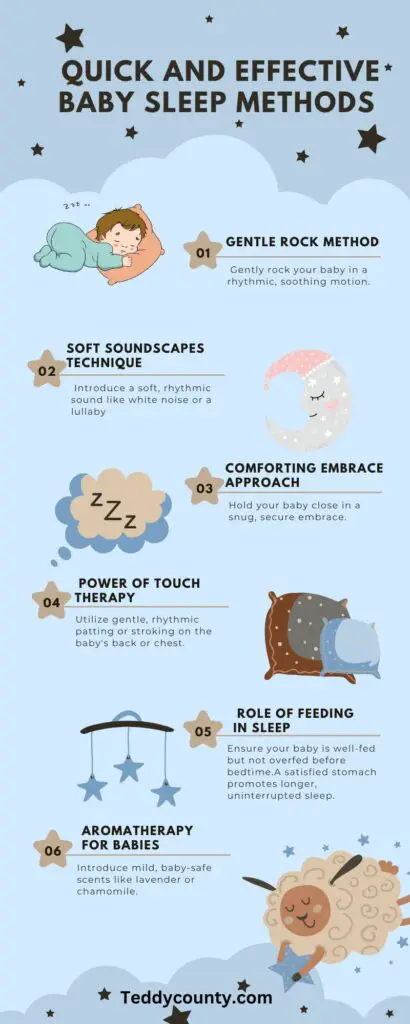Quick and Effective Baby Sleep Methods
In today’s fast-paced world, ensuring your baby’s restful sleep is a priority for every parent. Understanding the right techniques to put your baby to sleep quickly not only ensures their well-being but also allows you to manage your time efficiently. This comprehensive guide, How to Put a Baby to Sleep in 40 Seconds, delves into expert-endorsed methods and innovative approaches to help your baby drift off to sleep in under a minute.
Innovative Techniques for Speedy Baby Sleep
The “Gentle Rock” Method
Procedure: Gently rock your baby in a rhythmic, soothing motion.
To effectively implement the “Gentle Rock” method, start by finding a comfortable position, either sitting or standing, where you can hold your baby securely. Cradle your baby in your arms or a baby carrier, ensuring their head and neck are supported. Initiate a gentle rocking motion, focusing on a smooth, rhythmic sway rather than abrupt movements. The key is to mimic the natural movements they would have felt in the womb.
You might experiment with different positions, like holding your baby against your chest or in a side-lying position in your arms, to discover what is most soothing for them. The motion should be slow and steady, creating a tranquil environment that eases your baby into a state of relaxation and drowsiness.
Key Benefit: It mimics the comforting motion experienced in the womb.
The “Gentle Rock” method is effective because it replicates the natural, comforting motion your baby experiences while in the womb. This familiar sensation is inherently soothing to infants, as it reminds them of the constant movement they felt when their mother walked or moved during pregnancy. This replication of prenatal experiences can be incredibly effective in calming and comforting your baby, making it easier for them to fall asleep.
The rocking motion provides a sense of security and familiarity, which can be particularly helpful in soothing a fussy or colicky baby. It helps in transitioning from an alert and awake state to a more relaxed and sleep-ready state.
Optimization Tips: Use a consistent rhythm; soft humming can enhance the effect.
To optimize the “Gentle Rock” method, maintaining a consistent rhythm is crucial. Pay attention to the speed and intensity of your rocking, and once you find a rhythm that your baby responds well to, try to maintain it consistently throughout the rocking session. This consistency in rhythm helps create a predictable and soothing environment for your baby.
Additionally, incorporating soft humming or singing can significantly enhance the calming effect of the rocking. The sound of your voice not only provides additional comfort but also helps establish a stronger emotional connection with your baby. Choose a soft, lullaby-like tune or even a simple, repetitive hum. The sound should be soothing and at a low volume, as the goal is to relax your baby, not stimulate or excite them.
The combination of gentle rocking and soft humming can be a powerful tool for soothing your baby and preparing them for sleep. It’s a method that not only aids in quicker sleep onset but also strengthens the bond between parent and child, making it a cherished part of your daily routine.
The “Soft Soundscapes” Technique
Procedure: Introduce a soft, rhythmic sound like white noise or a lullaby.
When introducing these sounds to your baby, use a sound machine, a mobile app, or a simple audio player. Place the sound source at a safe distance from the baby’s crib or sleeping area to ensure it’s not too loud. The sound should be loud enough to be heard but not so loud that it’s startling or disruptive.
Experiment with different sounds to see which ones your baby responds to most positively. Some babies might prefer the sound of rain, ocean waves, or even a heartbeat. The key is to find a sound that your baby finds soothing and relaxing.
Key Benefit: Creates a calming environment, masking disruptive noises.
The main benefit of the “Soft Soundscapes” technique is its ability to create a calming and consistent auditory environment. This is particularly beneficial in households or areas where external noise can be unpredictable and disruptive. Sounds like white noise help mask these external disturbances, such as traffic, household noise, or even sudden loud sounds, which can startle and wake a sleeping baby.
The consistent nature of these sounds can also help signal to the baby that it’s time to sleep. Over time, the baby begins to associate these sounds with sleep, which can make the process of falling asleep easier and quicker.
Optimization Tips: Keep the volume low and consistent; avoid sudden changes in sound.
To optimize this technique, it’s important to keep the volume low. The sound should be a gentle backdrop to the baby’s sleep environment, not a dominating element. The recommended volume level is just loud enough to mask background noise but quiet enough to be comfortably heard at arm’s length.
Consistency in the sound is also key. Avoid sounds that have sudden changes in pitch or volume, as these can be startling. If you’re using a playlist or a mix of sounds, ensure the transition between tracks is smooth and seamless.
By incorporating the “Soft Soundscapes” technique into your baby’s sleep routine, you can create an effective, calming environment that promotes better sleep quality and duration. This method not only helps your baby sleep more soundly but also provides a more peaceful night for the whole family.

Advanced Strategies for Soothing Your Baby
The Power of Touch Therapy
Touch therapy, involving gentle tactile stimulation, is a powerful and nurturing way to soothe and comfort your baby. Here’s how to effectively implement and benefit from this approach:
- Approach: Utilize Gentle, Rhythmic Patting or Stroking on the Baby’s Back or Chest:
- Technique: Start by holding your baby in a comfortable position. Gently place your hand on their back or chest and begin a soothing patting or stroking motion. The touch should be light but firm enough to be comforting.
- Variations: Experiment with different types of touch, like circular motions or light massage, to find what your baby responds to best.
- Incorporation into Routine: Integrate touch therapy into your daily routines, like during bedtime, after a bath, or during feeding times, to help relax your baby.
- Benefits: Instills a Sense of Security and Comfort:
- Emotional Connection: The skin-to-skin contact involved in touch therapy helps strengthen the emotional bond between you and your baby. It’s a way of communicating love and security non-verbally.
- Physiological Benefits: Gentle touch can have physiological benefits, like stabilizing the baby’s heart rate, improving oxygenation, and even aiding digestion.
- Calming Effect: This method can be particularly effective for calming fussy or colicky babies, helping them feel more secure and less anxious.
- Best Practices: Use a Gentle Hand and Maintain a Steady Rhythm:
- Consistency in Touch: Maintain a consistent rhythm and pressure as you pat or stroke your baby. Sudden changes in the rhythm or force of touch can be startling rather than soothing.
- Reading Baby’s Cues: Pay attention to how your baby responds to different types of touch. Some babies may prefer a lighter touch, while others might find a firmer patting more calming.
- Hygiene and Safety: Always ensure your hands are clean and warm before starting touch therapy. Cold hands can be uncomfortable for your baby.
- Creating a Relaxing Environment:
- Ambiance: Enhance the effect of touch therapy by ensuring the surrounding environment is calm and soothing. This can include dim lighting, soft music, or a quiet space.
- Regular Practice: Making touch therapy a regular part of your interaction with your baby can yield long-term benefits, establishing it as a reliable method of comfort and relaxation.
Touch therapy is a simple yet effective way to provide comfort and security to your baby. It’s a nurturing practice that not only soothes your baby but also enhances the bond you share. By incorporating gentle, rhythmic touch into your daily routines, you create a deeper sense of connection and trust with your baby.
Aromatherapy for Babies
Technique: Introduce mild, baby-safe scents like lavender or chamomile.
- Choosing the Right Scents: When selecting scents for baby aromatherapy, opt for mild and baby-safe options. Lavender and chamomile are popular choices because of their gentle nature and calming properties. These scents are known for their ability to soothe and relax, making them ideal for use with babies.
- Methods of Dispersal: There are several ways to introduce these scents into your baby’s environment. Using a diffuser is a common method, as it disperses the scent gently throughout the room. Make sure to place the diffuser out of reach of children and use it in a well-ventilated area. Alternatively, you can add a few drops of baby-safe essential oil to a piece of cloth or a cotton ball and place it near the baby’s sleep area.
- Dilution and Safety: It’s crucial to dilute essential oils properly before use, as they are highly concentrated. Use a carrier oil like coconut or almond oil to dilute the essential oil before applying it to any fabric near your baby. Always follow safety guidelines and recommended dilution ratios.
Benefits: Aids in relaxation and promotes a calming atmosphere.
- Soothing Effect: Certain scents like lavender and chamomile have natural properties that can soothe and calm babies. They can be particularly beneficial during bedtime or naptime to create a peaceful sleep environment.
- Enhancing Sleep Quality: The use of these scents can help in establishing a calming bedtime routine, potentially improving the baby’s sleep quality. The familiar and soothing scent can signal to the baby that it’s time to wind down.
- Reducing Stress: Aromatherapy can also be beneficial in reducing stress and anxiety in babies, especially those who are fussy or colicky.
Usage Tips: Use scent diffusers or apply a small amount to bedding.
- Using Diffusers Safely: If using a diffuser, ensure it’s specifically designed for essential oils and place it in a safe, stable location. Use it intermittently rather than continuously, and only for a short duration each time, especially in a baby’s room.
- Application on Bedding: Another method is to apply a small amount of diluted essential oil to the baby’s bedding. Ensure that the oil is fully absorbed and dry before placing the baby in the crib. This can help imbue the sleep environment with a calming scent.
- Avoid Direct Skin Application: It’s generally advised to avoid applying essential oils directly to a baby’s skin, as their skin is much more sensitive than adults. If you wish to use it topically, consult with a pediatrician first and always conduct a patch test to check for any adverse reactions.
- Monitoring for Reactions: Every baby is different, and some might be sensitive to certain scents. Monitor your baby’s reaction when introducing any new scent and discontinue use if you notice any signs of discomfort or allergic reactions.
Incorporating aromatherapy into your baby’s routine can be a gentle way to enhance their relaxation and comfort. It’s important to always prioritize safety and consider your baby’s sensitivities when using any form of aromatherapy.
Nutritional Considerations for Better Sleep
The Role of Feeding in Sleep
- Understanding the Importance: The relationship between feeding and sleep in babies is significant. Proper feeding ensures that your baby is neither hungry nor overly full, both of which can affect their sleep. A well-fed baby is more likely to sleep through the night, reducing the likelihood of sleep disruptions due to hunger.
- Balancing Nutrition and Sleep: It’s crucial to balance your baby’s nutritional needs with their sleep patterns. This involves understanding how different foods and feeding schedules can impact sleep and making adjustments based on your baby’s reactions and needs.
Strategy: Ensure your baby is well-fed but not overfed before bedtime.
- Timing of Feedings: Plan the last feeding of the day to ensure your baby is satisfied before bedtime. This might mean a feeding right before the start of the bedtime routine or slightly earlier, depending on your baby’s digestion and sleep schedule.
- Observing Fullness Cues: Pay attention to your baby’s cues that indicate they are full, such as turning away from the bottle or breast. Overfeeding can lead to discomfort and disrupt sleep.
- Type of Food for Older Babies: For babies who have started solids, choose bedtime foods that are easy to digest. Avoid heavy, rich foods that might cause discomfort or indigestion.
Benefits: A satisfied stomach promotes longer, uninterrupted sleep.
- Reducing Nighttime Awakenings: A well-fed baby is less likely to wake up due to hunger, leading to longer stretches of uninterrupted sleep.
- Aids in Overall Sleep Quality: Adequate nutrition contributes to overall health, which in turn can improve sleep quality. A balanced diet ensures that your baby is getting the necessary nutrients to support healthy sleep patterns.
- Contributes to Sleep Routine: Feeding as part of the bedtime routine can signal to your baby that it’s time to wind down, reinforcing the sleep schedule.
Feeding Tips: Consider the timing and quantity of the last meal.
- Appropriate Portion Sizes: Ensure that the last meal is appropriately portioned to satisfy your baby without overfeeding. This may vary based on your baby’s age, weight, and overall appetite.
- Consistency in Feeding Schedule: Aim for a consistent feeding schedule, especially for the last meal of the day. This consistency helps regulate your baby’s internal clock and prepares them for sleep.
- Adapting to Growth and Changes: As your baby grows, their nutritional needs and appetite will change. Be prepared to adjust meal sizes and timing accordingly.
- Hydration: Ensure your baby is well-hydrated throughout the day, but avoid excessive fluid intake close to bedtime to reduce the likelihood of nighttime awakenings for diaper changes.
Balancing nutritional needs with sleep requirements is a key aspect of promoting healthy sleep patterns in babies. By ensuring your baby is well-fed but not overfed before bedtime, observing their cues, and establishing a consistent feeding routine, you can help enhance their sleep quality and overall well-being.



I loved as much as you will receive carried out right here The sketch is attractive your authored material stylish nonetheless you command get got an impatience over that you wish be delivering the following unwell unquestionably come more formerly again since exactly the same nearly a lot often inside case you shield this hike.
I simply could not go away your web site prior to suggesting that I really enjoyed the standard info a person supply on your guests Is going to be back incessantly to investigate crosscheck new posts.